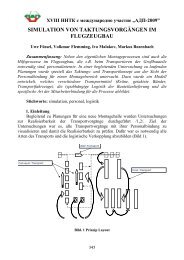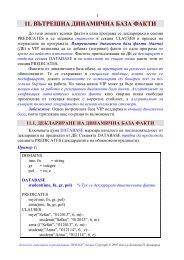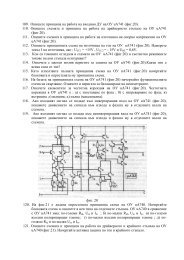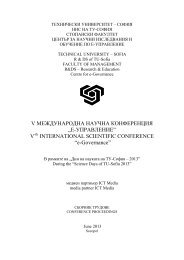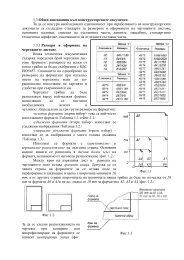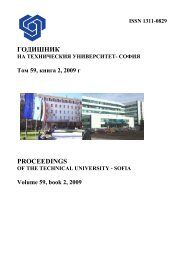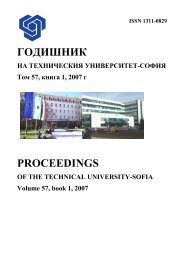Volume 61 Issue 2 (2011) - Годишник на ТУ - София - Технически ...
Volume 61 Issue 2 (2011) - Годишник на ТУ - София - Технически ...
Volume 61 Issue 2 (2011) - Годишник на ТУ - София - Технически ...
- No tags were found...
Create successful ePaper yourself
Turn your PDF publications into a flip-book with our unique Google optimized e-Paper software.
An additional analysis obtained at the reactor’s inlet showed that the CO formation isvery sensitive to the reaction of vinylidene oxidation (12) together with vinyl radicalrecombination reaction (13). These results confirmed the previously observed [6] majorrole of the vinyl recombination path for the acetylene oxidation in the rich conditions.5. ConclusionA considerable difference was found in the representation of the experimentallymeasured results for both investigated chemical kinetic schemes.In the USC mechanism the C 2 H 2 conversion shows a strong dependence on the T andthe mixture stoichiometry at the studied conditions. The reaction pathways of acetyleneoxidation in the USC mechanism considerably differ between rich and lean conditions.In the rich conditions the most favorable path was via the vinyl radical recombinationwhereas, in the much diluted conditions the C 2 H 2 oxidation goes preferablytrough the vinilydene oxidation at the early stage of the process and via keteneoxidation at the reactor’s outlet. Nevertheless, the mechanism failed reproducingquantitatively the experimentally measured temperature dependence of the C 2 H 2 decayand the CO and CO 2 profiles for the much diluted mixture.The Alzueta et al. model shows exactly the opposite tendencies with respect to the influenceof the temperature and stoichiometry on the acetylene conversion. On the contraryto the USC Model, the Alzueta et al. model describes more precisely the propertiesmeasured in the much diluted mixture.These results suggested the need of further investigation of the possible reactionchannels delivering the radical pool in the acetylene oxidation. A deeper analysis ofthe key reactions and their reaction rates would help improving the mechanisms predictability.AcknowledgementThe author acknowledges the COST Action CM0901 (EU) for the financial supportunder the Short Term Scientific Mission - „COST STSM Reference Number: COST-STSM-CM0901-7289”. A deep gratitude is expressed also to the host institution(Aragón Institute of Engineering Research (I3A), University of Zaragoza, Spain) inthe face of Professor M. U. Alzueta for her exclusive support of this work. Sincerethanks to Dr. R. Quiceno, Shell Global Solutions, Chester, UK, and Dr. J.Marquetand,IWR Heidelberg University, Germany for their useful comments and fruitful discussions.227



